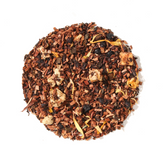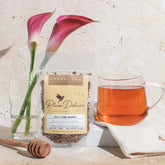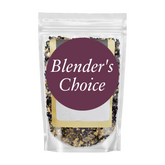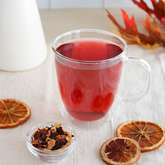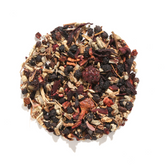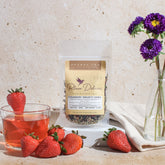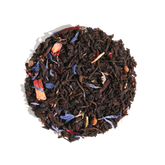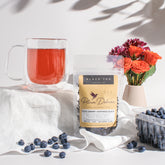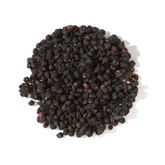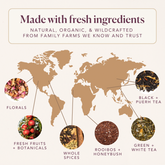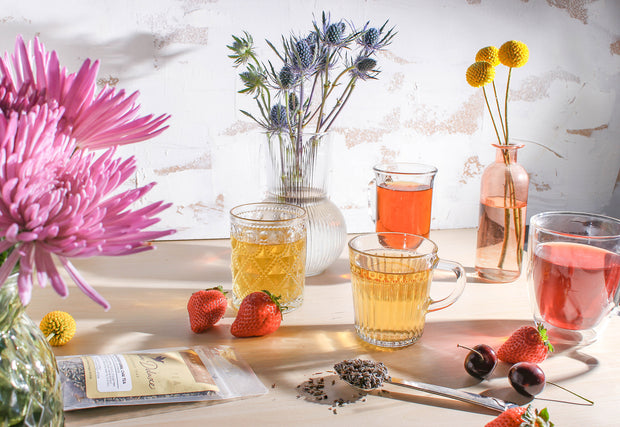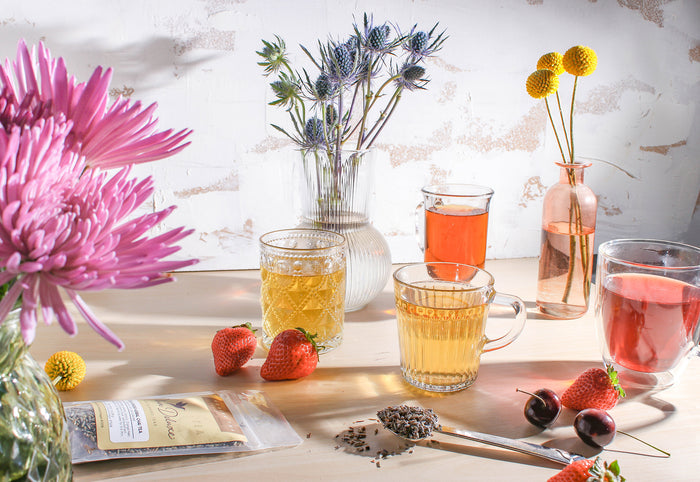
What is Tisane Tea?
First things first, tisane tea is often called "herbal tea," but it’s not really tea at all. Misleading, isn’t it? We often call it herbal tea due to the use of other herbs, fruits, or flowers being infused into water.
True tea comes from the drying of leaves from the Camellia sinensis plant, whereas tisanes use plants other than the tea plant in their blends. "Tisane" is the French word for "herbal infusion" and denotes brews that use only fruit, bark, flowers, seeds, roots, or plants other than tea to form the base for the blend.
Are There Different Types of Tisane Tea?
Tisanes can use a number of different plants in place of the tea, making sub-categories of tisane. Here are a few of them.
Floral Tisane Tea
These blends use floral plants as the base for the blend. Common examples include chamomile, hibiscus, lavender, elderflower, or rose-based blends. These blends are usually very pretty visually and smell wonderful due to the fragrant buds included in the blend.
Here are some of our favorite floral tisane blends: (If you want some tips on getting the most out of your floral blends, check out our article, "Drink Your Flowers.")
Leafy Tisane Tea
These blends use plants that are leafy in nature. These may be the blends that get the "herbal" tag commonly attached to them. Leafy tisanes include blends using mint, lemongrass, lemon balm, honeybush, or rooibos as the base for the blend.
Here are a few leafy tisanes to brew for your next cuppa:
Bark Tisane Tea
This group of tisane uses the bark of some plants to make an earthy blend. Examples include slippery elm and cinnamon.
Looking to check out a bark tisane? Here are a few we like:
Root Tisane Tea
These blends use roots such as ginger, chicory, and echinacea to form the base of their tea.
Try these:
Fruit Tisane Tea
Fruit tisane tea uses fruit as the base of its tea. These blends are lovely hot but also make wonderful iced tea. Check out the end of this article for some iced tea suggestions with fruit tisane. Examples of fruit-based tisanes can include (but aren’t limited to) apple, elderberry, raspberry, and peach.
Here are a few fruity tisanes to explore: Some blends may use a number of the ingredients from the sub-categories above, but the main thing to remember is that if the blend doesn’t have tea in it, it’s considered a tisane.

Should I Drink Tisane Tea?
Because these blends don’t use the tea plant, they’re often caffeine-free. So if you’re caffeine sensitive or looking for a blend to enjoy before bed, tisane tea is a good option to sip on.
Because tisanes use non-tea plants, some can offer health benefits that can be useful. Elderberry, for example, is wonderful for colds and flus as it is believed to help stop viruses reproducing in the body. Ginger is well known to assist with nausea. Lemon balm is a smooth muscle relaxant used to aid digestion.
Looking for more herbal teas to help your health? Check out our article, "Herbal Tea Ingredients that Improve Your Health."
As with trying anything, remember to exercise some caution; whilst many teas have health benefits, we want you to be as safe as possible. Some teas can interact with medication or pre-existing health conditions, so chat with your healthcare professional before trying to use tisanes to treat any conditions you may have.
That being said, tisane teas are a wonderful thing! These blends were the original way I began to drink tea, as the range of flavors appealed to me. Now I drink a mixture of tisanes and black tea blends, but the tisanes are still among my favorites.

Brewing Tips for Tisane Tea
Because of the broad variety of ingredients that can be present in a tisane tea blend, you may need to adjust how you brew your tea accordingly. Try adjusting the amount of time you steep your tea for, or the temperature of your water. Adding milk or a sweetener such as honey is another option for adjusting the flavor of your brew.
For more tips, check out our article, "How To Make Herbal Tea Taste Better."
What Else Can I Do With Tisane Tea?
Whilst there is nothing wrong with brewing and enjoying a hot cuppa tisane, there are other ways to enjoy your favorite blend.
Tisanes tea makes wonderful iced teas. Check out our recipe for iced tea, choose your favorite tisane blends, and make up a pitcher. Perfect to enjoy as the weather warms up!
Alternatively, make ice pops with your tisane blend for a refreshing and tasty summer treat.
After something a little bubbly? Consider trying to make your own carbonated tea or a fruity agua fresca. Both of these recipes can be adapted to accommodate your favorite tisane blend, so great creative!
If you decide to try one of these recipes out, or you’re just brewing your favorite cuppa, don’t forget to share your wonderful tea creations with us by tagging @plumdeluxe on social media.


![Plum Deluxe Iced Tea Sampler Pack [6-Pack Variety of Flavors]](http://www.plumdeluxe.com/cdn/shop/files/ICEDTEA_2.png?v=1746755007&width=165)

